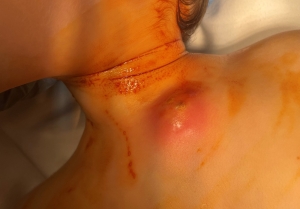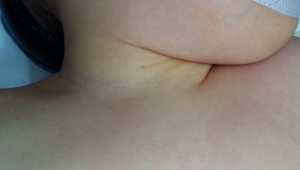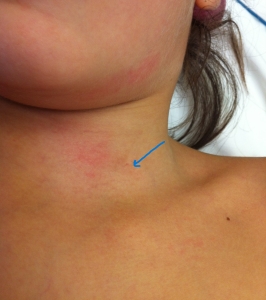My child has a small hole in their neck that sometimes gets wet… Branchial cleft problems…
October 2023
The other day, a 3-year-old girl came in. Under her neck, under the skin, there was a large abscess as you can see in the photo on the side.

When I questioned her in detail, I learned that there used to be a tiny hole in that area, and occasionally, the mouth of this hole would get wet. We drained the abscess, and we are waiting for it to heal before removing the problematic area with surgery. When the mother said she didn’t know that this hole was a serious problem, I thought it was necessary to write this blog.
It’s quite difficult to explain without medical terminology. Let me put it this way. Imagine the image of a baby in the mother’s womb that you see everywhere. You can easily find pictures of it on the internet. In the first weeks, there are structures on both sides of the baby’s neck that resemble gills. These structures are called clefts, and the protrusions are called arches, and these structures turn into organs like our jaw, ear, and the non-functional ones disappear. But sometimes things don’t go as planned. The ones that should disappear don’t, and they remain as residue.
The arch residues are usually located right under the skin, hard structures like cartilage form, as seen in the photo on the side.

From cleft residues, sometimes cysts develop, sometimes channels that extend from the mouth to the skin, called fistulas, develop, and sometimes there are blocked cavities that go inward from the skin, called sinuses. Depending on which cleft residue remains, they can settle in the areas from the ear to the bottom of the throat. But most often, they occur in the lower part of the big muscle on the neck, in the third and fourth branchial areas. They mostly occur on the side of the neck. The cystic structures in the midline of the neck are more likely to be thyroglossal cysts or dermoid cysts, as I mentioned before in previous blogs and vlogs.
We most commonly encounter residues from the second or third clefts. Residues from the second cleft can create a channel from the neck to the tonsils, and residues from the third cleft can cause problems by extending to the area behind the vocal cords. It’s because of these channels that there can be discharge from the skin hole.
 In the photo on the side, the hole in the neck is clearly visible. If the channel is completely open, there can be discharge like saliva, and if the end is a blind sinus, we can occasionally encounter discharge in the form of secretion produced by epithelial cells inside the sinus.
In the photo on the side, the hole in the neck is clearly visible. If the channel is completely open, there can be discharge like saliva, and if the end is a blind sinus, we can occasionally encounter discharge in the form of secretion produced by epithelial cells inside the sinus.


Again, in the photo on the side, my arrow points to the hole, and it’s clear how a long channel came out during surgery.
Although those seen as small holes from the outside may seem harmless, they can present with abscess findings like in the child I mentioned at the beginning. Branchial cleft cysts are very rare, but they make up about 20% of neck masses seen in children. They can grow large enough to be visible from the outside and resemble a soft, fluid-filled balloon. Although they may seem harmless, especially if they produce discharge, become inflamed, or form an abscess, it is preferable to remove them before these problems occur.
In the operating room, under general anesthesia, we remove abnormal tissues to prevent the child from feeling pain and remembering moments of anxiety. Usually, these are outpatient or one-night stays. Sometimes we may need to place a drain. If the channel is long, we may need to make more than one incision. Your surgeon will explain the details to you based on the type of residue.
These types of surgeries are special and require meticulous work. No matter how careful we are, there is a possibility of recurrence, but this probability increases significantly when there is an infection. Additionally, even though we wait for the infection to clear, the tissues that form in the area can hinder our work.
So, it’s best not to wait. If you see a hole in your child’s skin on the neck, especially if there is occasional moisture coming from this hole or if you notice swelling in the neck, be sure to consult your doctor.
Let’s end this journey like this. Please don’t forget to like and subscribe.
Stay happy,
September 2023
Prof. Dr. Egemen Eroğlu




 In the photo on the side, the hole in the neck is clearly visible. If the channel is completely open, there can be discharge like saliva, and if the end is a blind sinus, we can occasionally encounter discharge in the form of secretion produced by epithelial cells inside the sinus.
In the photo on the side, the hole in the neck is clearly visible. If the channel is completely open, there can be discharge like saliva, and if the end is a blind sinus, we can occasionally encounter discharge in the form of secretion produced by epithelial cells inside the sinus. 
